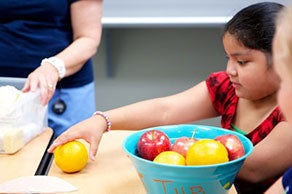Healthy Reminders & Resources
 Healthy Tips For Success
Healthy Tips For Success
- Keep food records has been shown to improve progress toward healthy eating.
- Add Fruits and Vegetables to the daily menu – Aim for 10 servings each day
- Replace bread, rice, and pasta with 100% whole grains
- When preparing meals choose lean meats and bake, broil, or grill them. REMOVE ALL SKIN
- Reduce fast-food/eating out and prepare home-cooked meals
- Replace sugary drinks with no-calorie drinks
- Increase WATER.
- Drink either skim milk or 1% milk if older than 2 years old.
- Eat more fruit instead of drinking juice
- Get MOVING and LESS screen time. Be ACTIVE EVERYDAY!
- Most children and teenagers require 8-10hours of sleep every night
How to Reduce Added Sugar in Your Child’s Diet: AAP Tips

On average, sugar makes up 17% of what children consume each day.
That's a lot of sugar―and half of that comes from drinks with added sugar!
What's Added Sugar?
Many foods or beverages have extra sugar and syrups added to them when they are processed or prepared. These added sugars have many different names, such as brown sugar, corn sweetener, corn syrup, dextrose, fructose, glucose, high-fructose corn syrup, honey, lactose, malt syrup, maltose, molasses, raw sugar, and sucrose.
In a joint policy statement, the American Academy of Pediatrics and the American Heart Association explain the health consequences of this added sugar problem and what can be done to reduce kids' consumption of sugary drinks.
Tips to help your family reduce their added sugar intake
- Read nutrition facts labels carefully. Many foods now list added sugar separately. You also can find added sugar by reading the ingredients. Aim for less than 25 grams (about 6 teaspoons) of added sugar per day for children 2 years of age and older. Avoid serving foods and drinks with added sugar to children under 2 years of age. Learn more about nutrition facts labels here.
- Serve water and milk. Avoid soda, sports drinks, sweet tea, sweetened coffee, and fruit drinks. Milk contains natural sugar (lactose) and provides calcium, protein, vitamin D, and other nutrients children need.
- Limit fruit juice. It has more sugar per serving than whole fruit. The AAP recommends no more than 4 ounces of 100% fruit juice a day for children ages 1 through 3 years; 4 to 6 ounces for children ages 4 through 6; and 8 ounces for children ages 7 through 14. Do not give fruit juice to infants under 1 year old.
- Go fresh and limit processed, pre-packed food and drinks. Sugar is often added to them while they are being made or at the table. For example, there are hidden sources of added sugar in processed foods like ketchup, dried cranberries, salad dressing, and baked beans.
- Satisfy your child's sweet tooth with whole fruit.
Featured Recipe - Sweet-and-Sour Chicken

1bag (12 oz) frozen vegetable stir-fry
1 Tbsp peanut oil or vegetable oil
1 Tbsp ginger minced
1 Tbsp garlic, minced (about 2-3 cloves)
1 Tbsp scallions (green onions), rinsed and minced
2 Tbsp rice vinegar
1 Tbsp Asian hot chili sauce
2 Tbsp brown sugar
1 Tbsp corn starch
1 C low-sodium chicken broth
12 oz boneless, skinless chicken breast, cut into strips
1 Tbsp light soy sauce
- Thaw frozen vegetables in the microwave (or place entire bag in a bowl of hot water for about 10 minutes). Set aside until step 6.
- Heat oil in large wok or sauté pan over medium heat. Add ginger, garlic, and scallions, and stir fry until cooked, but not browned, about 2-3 minutes.
- Add the rice vinegar, chili sauce, and brown sugar to the pan, and bring to a simmer.
- In a bowl, mix cornstarch with chicken broth, and add to the pan. Bring to a boil over high heat, stirring constantly. Lower heat to a gentle simmer.
- Add chicken, and stir continually for 5-8 minutes.
- Add vegetables, and mix gently. Simmer with lid on to reheat, about 2 minutes.
- Add soy sauce, and mix gently.
- Divide into four even portions, and serve.
Serve with a side of steamed brown rice.
Serving size: 3 oz chicken, 1 C vegetable; calories: 221; total fat: 6g; carbohydrates 21g
Resources
Additional Recipes & Resources
Thanksgiving Menu
Keep the Beat Cookbook- Heart Healthy Recipes from the National Heart, Lung and Blood Institute
Keep the Beat Cookbook (revised)
National Nutrition Month 2009 Recipes
Aim for a Healthy Weight
Take Charge for Teens
National Heart, Lung, and Blood Institute
Carbohydrates and Sugar (for parents)




